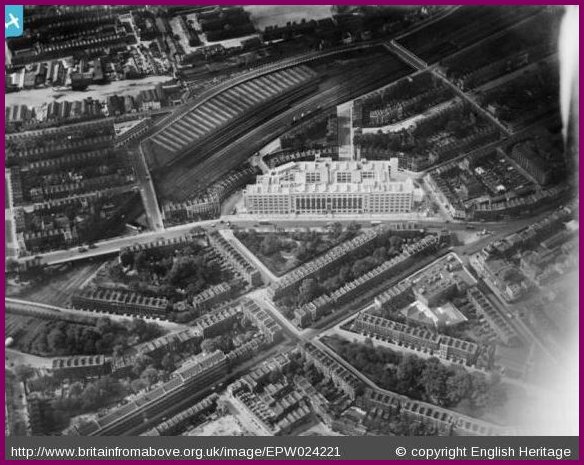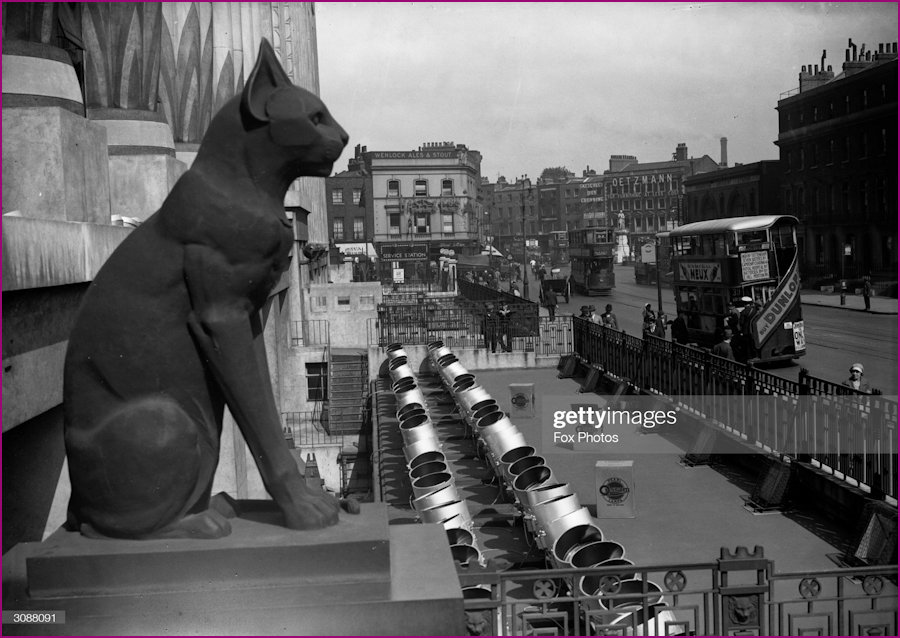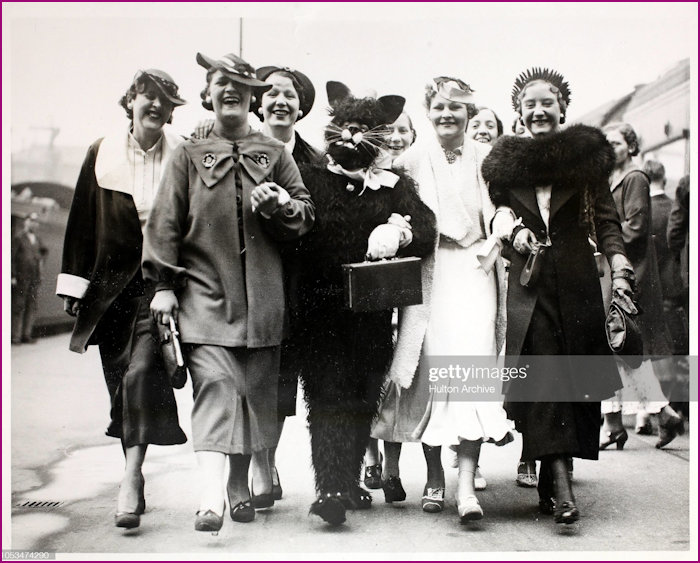Black Cat Factory
Home Page / Art Deco Home / Black Cat Factory Home / Black Cat Unique
Modernist Britain
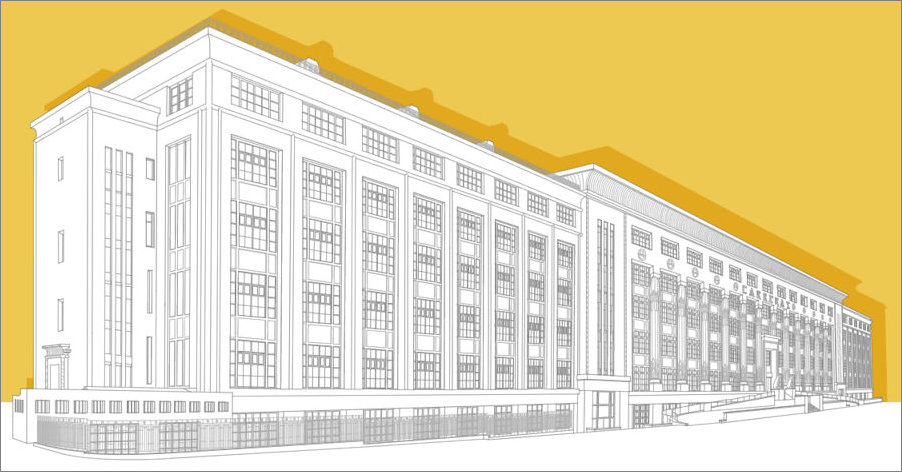
Image courtesy and © of Modernist Britain
From the website :
Standing on Hampstead Road in North London, opposite Mornington Crescent tube station and half a mile north of Euston Road, the Arcadia Works was built between 1926 and 1928 for the Carreras Tobacco Company. The company was established in 1788 and started business in London in the mid-1850s. By 1907 the company had a large works on City Road (which runs roughly from Moorgate north-west to Angel) in North London. By 1927 the company had outgrown its City Road works. The company commissioned plans for a new London headquarters for the company.
Arthur George Porri submitted plans for a classical-influenced building whilst architect Marcus Evelyn Collins suggested a stylised Egyptian frontage. The Egyptian style echoed the increasing influence of Egypt on art and design following the opening of Tutankhamun's tomb in 1922 by British archaeologist Howard Carter. The Egyptian design was married to Porri's overall scheme. The design of the building was credited to the practice of Marcus Evelyn Collins and Owen Hyman Collins with A G Porri and Partners as consultant.
Marcus Evelyn Collins was born in 1861 and died in 1944. His father, Hyman Henry Collins (1883 - 1905) was a well-known architect having designed the New London Synagogue in St John's Wood, London. Marcus Evelyn Collins and Owen Hyman Collins worked in practice in London until March 1939 when the partnership was dissolved, although both continued in practice, albeit separately from the same office at 115 Old Broad Street in London.
Arthur George Porri was born in 1877 and died in 1962. He was also responsible for the Eli Lilly building on Kingsclere Road in Basingstoke. The building, a four-storey laboratory, is another Modernist industrial works.
The Arcadia Works, also known as the Carreras Cigarette Factory, is a large imposing building, with its frontage on Hampstead Road extending for more than 500 ft. The design comprises an, at the time, unique pre-stressed concrete frame. The company publicised the Arcadia Works as 'London's Most Hygienic Tobacco Factory', by virtue of its air conditioning and dust extraction plant.
The main entrance to the building is flanked by two 8 ½ft high bronze statues of the cat-goddess Bastet (Carreras used a black cat on its Craven A cigarette packaging). The main frontage comprises a central block of 13 bays with two lower wings of eight bays either side. The bays within the central section are separated by columns with Egyptian-stylised capitals.
The bays, from the first floor level, are filled with tall metal-framed windows. Window blanks disguise the floor level allowing the windows to rise uninterrupted for four storeys. Above, the company name 'Carreras' is spelt out in raised Egyptian-style lettering. Either side, for the outside ten bays, reliefs showing the face of Bastet are placed in circular recesses. Above, a further storey with metal framed windows is surmounted by a highly decorative, deep cavetto-form parapet.
The lower wings are simpler in design with mouldings separating the eight bays. These wings also feature the same deep parapet, although plain in decoration. At pavement level ornamental railings featuring Egyptian hieroglyphs surround the building. The rear of the building is much simpler, with plain walls with large windows. A tall chimney rises high over the building.
The building was officially opened with great fanfare on 3 November 1928. The pavements were covered in sand, opera singers from a London staging of Verdi's opera Aida and actors in Ancient Egypt-style costumes performed, while chariot races were held on the street. The company struck a commemorative medal in celebration for all 3,000 employees, with the inscription 'My Thanks For All Your Help - Bernhard Baron, Chairman, Carreras Ltd'.
In 1959 the Carreras company merged with the Rothmans company and the new company relocated. The Arcadia Works was put up for disposal. By that time the Egyptian styling had fallen out of favour. In 1961 all traces of Collins' scheme were obliterated, with the columns 'boxed' in. Renamed Greater London House, the Arcadia Works was used as office space.
In 1996 Greater London House was acquired by Resolution Property. Executive architects Finch Forman and design architects Munkenbeck and Marshall were commissioned to restore, as far as possible, the original Egyptian scheme. The project including reinstating two replica cats outside the main entrance. The restoration won a Civic Trust Award and a Camden Design Award, and the project was featured as Building of the Month in the RIBA Journal.
The Beginning
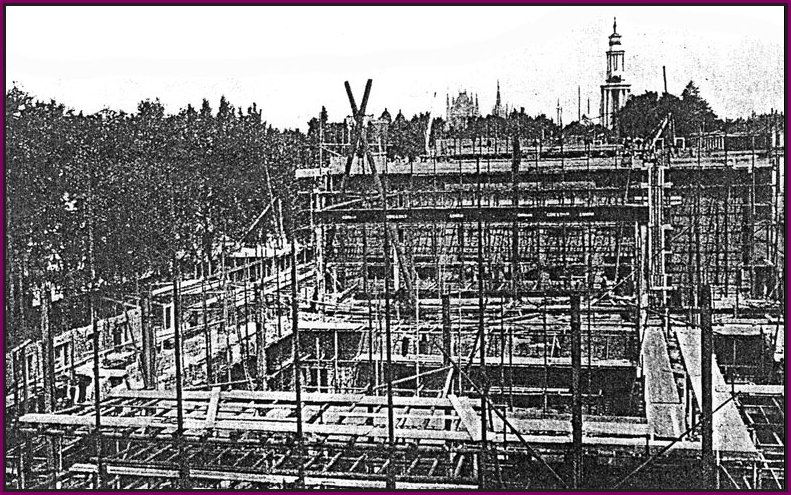
Building operations at Endsleigh Gardens, Euston Road, c. 1928 (St Pancras Church can be seen in the distance)
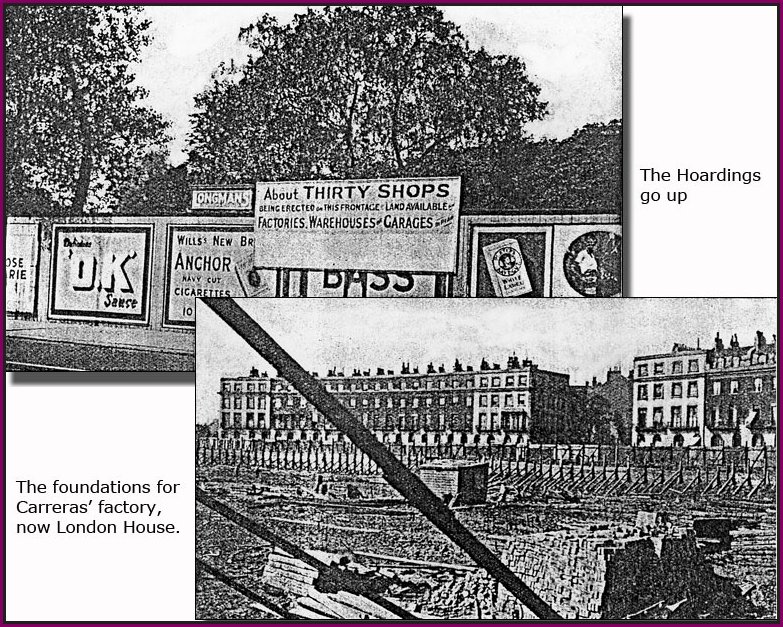
Pictures of Mornington Crescent, with hoardings and during development
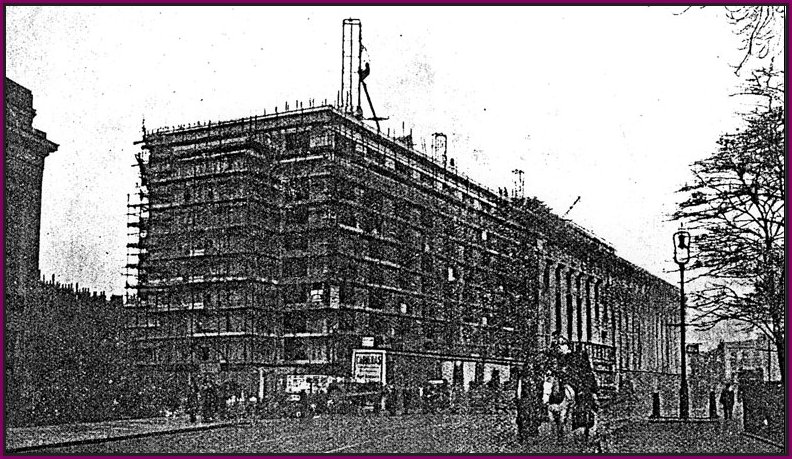
The huge factory built over the valuable garden space of Mornington Crescent,
Camden Town, N. London.
Note, on left, the original houses overshadowed by its bulk
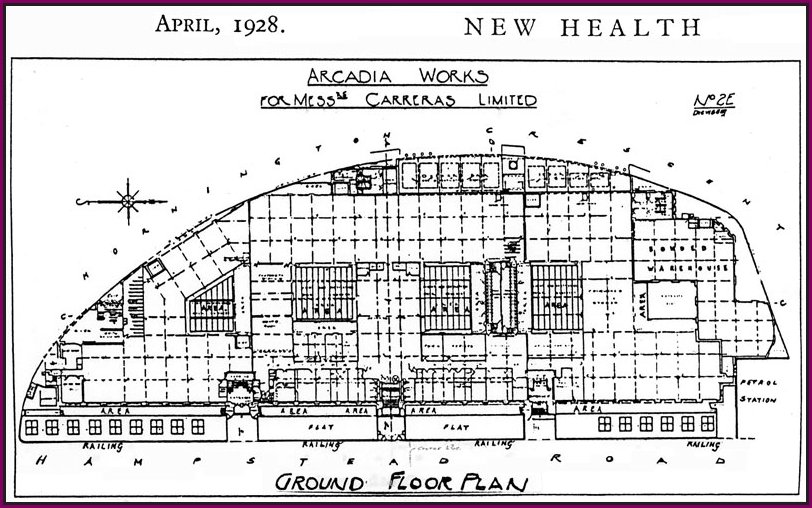
New Factory for Messrs, Carreras Ltd., Hampstead Road NW1
Architects, M.E. and O.H. Collins .Contractors, Sir Robert McAlpine & Sons.
The aerial image from the Britain from above website shows the enormous expanse of the factory building.
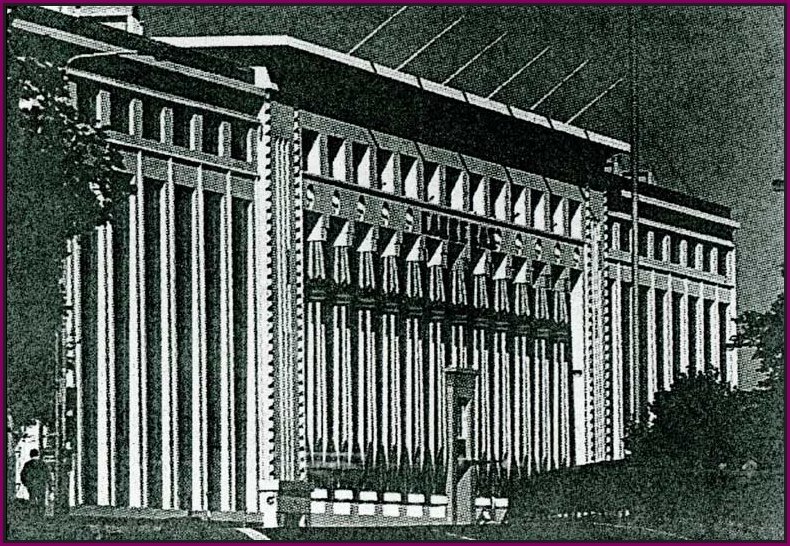
The new Carreras factory about 1929, in all its Egyptian finery
For more up to date images of the factory as it looks today - please return to the Black Cat Factory page
From the Camden Town Local History website
New Health
Mornington Crescent was only one of the many squares and crescents under threat by developers in the 1920s. Another was Endsleigh Gardens, opposite Euston Station. It had been an open space full of trees, but was now lost to the public. This is the block which now contains the Friends’ Meeting House. Coram Fields and many other green lungs were under similar threat.
In April 1928, ‘New Health’, a periodical which fought for open spaces in cities and the health which they could bring, was up in arms about the planned loss of Mornington Crescent Gardens. Fresh air was the sole known cure for killer diseases such as tuberculosis. Streptomycin, which emptied our TB hospitals in the early sixties, was thirty years away. New Health contrasted the trees and open space with the effect of a new factory on the area.
Captions from 'New Health'
"Look at this picture which shows the gardens at Mornington Crescent some years ago, when trees and shrubs and grass brightened the surroundings of this North London district."
"And on this, after the builder has fallen upon the ground and work has commenced for the erection of a great factory."
The New Health article went on to demand that all new factory building should be outside London as there was plenty of room in the countryside and London needed its open spaces to give the population fresh air and health. It was partly this thinking which would begin to empty Camden Town of manufacture thirty years later, well after Mornington Crescent Gardens had been built over and, incidentally, just when Streptomycin was beginning to solve the Tuberculosis problem.
The Carreras 'Black Cat' Factory
In 1927, when the factory was being designed, interest in Egyptian history was widespread. Lord Carnarvon had discovered the tomb of Tutankhamen a few years earlier and a number of 'Egyptian' buildings were being erected at this time, including the Hoover factory on the A40 into London and a cinema in Essex Road. The association with Black Cat cigarettes, then a popular brand, related to an earlier period in the Company history. A Spanish nobleman by the name of Carreras, banished from his country, set up in London's Wardour Street and began trading as a tobacconist/herbalist. He had a black cat which, on sunny days, sat in the window of his shop. Londoners wishing to buy tobacco used to ask cab drivers to take them to the tobacconist's shop in Wardour Street with the black cat in the window, because the name Carreras was difficult to pronounce. Thus the Black Cat name became famous. The combination of the Egyptian theme and the Black Cat, led to the Egyptian Cat Goddess, Bast and helped decide the system of decoration. Local people still call the building the Black Cat Factory.
The new factory was to be enormous - the largest reinforced-concrete factory in the country. Five floors would completely fill the gardens. Not an inch was to be left and everything green would disappear.
Five deep light wells were to penetrate the building, bringing light and air to the interior, while the top floor was to have north-facing lights, so that heat would not build up in strong sunshine.
Pictures of the building under construction show three tall steel towers, the forerunners of our modern tower cranes, and huge walls of wooden shuttering for the concrete. Trams and buses with outside staircases pass along Hampstead Road. When built, the whole of the exterior (except the coloured parts) were rendered in white cement and sand to give a warm stone-coloured finish. The brilliant Egyptian decorations were produced by mixing ground glass with cement and grinding off. Thus the colours were permanent and, when dirty, could be washed.
The First Reactions
In 1928, the reviewer in 'Building' was very doubtful about the design of the factory. The idea of dressing up a modern factory as an Egyptian temple was disturbing, but the mass of the building, its form and general composition, were unexpectedly beautiful. He closed his eyes to the decoration and looked at the building beneath. The 'sense of beauty' given by the gentle inward slope of the walls, typical of Egyptian building, is particularly satisfying.
Of course, the inside walls are vertical, as with Egyptian mud-brick building, but from the outside they slope inwards, gradually tapering in thickness to the top. An inward slope, or batter, is very rare in reinforced-concrete work, but when we see the factory today, with the Egyptian fancy dress gone, we see the building as the reviewer in Building imagined it and so can judge it on architectural merits alone. The reviewer too was very impressed with the beauty of the vast concrete interiors, 'unplastered and straight from the shuttering (just stoned down and white-washed over)’. Although he did not know it, this as an early example of New Brutalism, but the coloured decoration protected it from that name at the time.
The History of the Rothman Tobacco Firm
The modern firm of Rothman had been founded by Bernhard Baron, who had come to England from Kiev, via the United States. There is an old news film about the opening of the Carreras factory which seems to be from another age. It records the opening ceremony and shows Baron being greeted by a vast crowd. Apparently almost all the 3,000 workers, mostly women, are waving at him. Other pictures show them crowding into the main doors on a working day in such numbers that the scene looks like Wembley five minutes before the kick off.
The original silver nitrate film has been transferred to video, silent and jerky. Short panels of text say:-
'800 men built the House of Carreras, the largest reinforced concrete building under one roof in Great Britain, in 18 months.'
'The modern factory designed after the Egyptian goddess Bast, the Cat Goddess, is guarded by two bronze cats of ancient Bubastis ten feet in height.'
'The flanking pillars, 47 feet high, with brilliant and handsome colourings ground from glass, to outlast the centuries; with the winged orbs of Rah, the sun God above.'
'2.800 tons of steel rods and 77,500 tons of concrete were used in the building of Britain’s largest factory.'
'Nine acres of floor space were covered with 400.000 square feet of Canadian maple.'
Our modern reaction to the film is very different from the impression it must have made on its first audiences, because we have the advantage of hindsight. In the nineteen-thirties we regarded cigarettes as a source of harmless pleasure. We watched Hollywood films and copied the way the film stars lit their cigarettes. Whenever an actor on the stage needed some 'business' to cover a pause, or hoped to take the audiences' mind off the quality of the dialogue, he flourished a cigarette case. Every theatre programme used to carry the acknowledgement, 'Cigarettes by Abdulla', because Abdulla gave free cigarettes for use on the stage.
Thus, when Carreras moved to Camden Town here was pleasure and relief at the prospect of employment. Hundreds of people would have the chance to work in a modern factory which had the latest air conditioning. The film opens with pictures of the park at Mornington Crescent, full of small trees, almost as Ginner and other artists in the Camden Town Group had drawn it before the First World War.
It then traces the making of cigarettes in their millions. Women open bales of tobacco leaves and rapidly strip out the hard central vein, with the dust of broken tobacco leaves rising in their faces for eight hours a day. This was passive smoking, but nobody knew. Smoking cigarettes was glamorous, not stupid. Reading the laudatory film captions about the new factory, we are shocked. Not until the computer death figures began to appear nearly forty years later, did we realise the danger of cigarette smoking, while the risk to passive smokers like these took us even longer to recognise. Watching the film today we look on now helpless, unable to warn them of their likely fate.
All methods of advertising were used to keep up sales. 'Club brand’, made at the Mornington Crescent ‘Arcadia Works’, was the first to give coupons which could be exchanged for goods of all type. In that realistic 1930 world, some of the most popular 'prizes' were boots and shoes. Smokers came to the main entrance, collected their footwear and changed into the new ones at once. So many left their old boots and shoes on the doorstep that one boy had the special job of collecting them every few hours to keep the place tidy. Mr King remembers going up the splendid 'marble' staircase and handing in the coupons. His brother too got his first overcoat with coupons.
Every street in Camden Town provided workers and, since it was the policy to employ families wherever possible, whole households worked there together. This made for a more stable workforce and created a subtle type of discipline. If a younger member of the family was not behaving well, a word to an older relation often settled the matter. This policy of employing families was pursued by Gilbey's and other local factories until the 1960s, when the patterns of employment and the early breaking up of families into separate households, often living far apart, made it impracticable.
On Christmas Eve the family party often started in the factory. Any musicians were encouraged to bring their instruments. At about 3 o'clock, the band started at the top floor and formed a conga chain, dancing through the factory, floor by floor, until it emerged at the main entrance as an excited throng and held up the traffic in the Hampstead Road.
Camouflaging the Factory
In 1939 the factory was camouflaged in broad patches, which appeared to make it even more gaudy and conspicuous than ever, but it looked different from the air. After the War the camouflage was removed and the Egyptian decorations were restored. However, the proud boast of 'outlasting centuries' seemed unlikely to come about, for in 1958-60 the Carreras factory was relocated to Basildon, Essex. Some workers went with the firm to the new town, and its new houses, while others had to find what other London work they could. Rothman’s were to move again from Basildon to Aylesbury, but that factory too is now closed. One of the famous cats was in store and the other is at the Rothman factory in Jamaica.
Modernising the building
When Rothmans had left, the factory stood idle. The building was refurbished. Windows were replaced. All the glass-decorated pilasters were built in as square columns; the winged orbs of the Rah the sun god above the entrance were removed; the building was given a plain colour wash, and the factory could be seen at last as a modern building. With the Egyptian decorations removed, many ‘Egyptian ‘ features remained. There were still the ‘battered’ walls, sloping in gently towards the top; the cavetto mouldings at the roof; the Egyptian shape of the building, the tall, narrow window openings, used by the Egyptians; a row of circular patches along the front which were part of the original Carreras decoration; and the iron railings with their hieroglyphic motifs. Despite these traces of the past, it became the modern building with its simple inwards ‘batter’, first envisaged by the critic in ‘Building’, in September 1928
The factory was renamed ‘Greater London House’ and the Thomson Travel Company has been located there for many years.
The 1997 Changes
In March 1997 the building changed hands. The new Taiwan-based owners submitted plans to restore the building, replace all windows to match the 1920s originals and reintroduce the 12 foot high black cats at the entrance. The original columns, with their glass decorations have been too damaged by building them over into square columns for the originals to be restored, but new ones would be built over the top of the old and painted to the original colours. The huge black cats would be replaced, and an ‘Egyptian’ building was to become a post-modernist Egyptian one.
It is a very well designed building, with high ceilings and large open floors, ideal for a computer-run world. Modern offices bear little relation to the traditional office of high desks and coal fires. Dickens, who went to school just by Mornington Crescent, and Bob Cratchet, his clerk in The Christmas Carol, are both long dead. Instead of ledgers and dusty files stored in attics and tied with tape, each person has a computer. This can be plugged into any socket, or worked by batteries. Today many office workers are ‘nomads’, travelling around from site to site, customer to customer, and have no need for a permanent space. They can use any convenient empty desk and call up their files on their lap-tops. They have a cubic metre of drawer space in a steel filing cabinet, a lap-top computer and a car which doubles as an office.
Thus many modern offices need only a reception area; rooms for meetings; some small office cubicles where one can work quietly for an hour; a place where people can meet casually; and a kettle for making tea. Architects will need a drawing board and a computer, but even these may sometimes be shared. Solicitors still require a permanent room where the door can be shut and confidential matters discussed in private. Most work however is not very secret. It is routine and can be conducted in open offices.
This is the new pattern for Greater London House. A number of flexible office spaces capable of being used in many different ways, with good communications, minimal overheads and a newly refurbished Mornington Crescent Station outside.
Kentish Towner
A well written piece reproduced below - original source here
An early view of the factory (no provenance given) as it appears in the Kentish Towner
Carreras Art Deco Cigarette Factory, Mornington Crescent
The chequered history of the huge Egyptian-themed building that wiped out much-loved communal gardens
Could this be the most gloriously incongruous building in all North London? Giant Black Cat statues; oversized Art Deco grandeur; curious hieroglyphic stylings. Along with Western Avenue’s celebrated Hoover Building-turned-mega-Tescos, Greater London House (to use its bland current name) is among the capital’s finest eye-popping examples of Egyptian-influenced Art Deco architecture.
As the progressive spirit and indelible social changes of industrialisation swept the world, the great tombs of Tutankhamen and his bejewelled, mummified ilk were being revealed along the Nile, proving a popular theme for industrialists wanting to make the thrusting testosterone-heavy corporate HQ statements of the day.
Until 1926 the site had held a sweep of communal gardens fronting a quite desirable Mornington Crescent, part of the Duke of Bedford’s swanky Estate. But a wily developer managed to snap up the land rights to the gardens; the horror at their destruction actually proved enough to spur the foundation of the Royal Commission on London Squares.
Looking on the bright side though, the subsequent erection of such a colossal work facility saved Mornington Crescent tube station, under the shadow of closure since 1924. And despite its Crescent oasis-obliterating birth, the aerial shot from the year of completion shows a rather grand addition to the stuccoed terraces and railway lines all round.
Harrington Square sits opposite, barely recognisable as a much smaller triangular feature of the 1840s Bedford Estate back in those days. Heavy bombing of Euston in WWII, followed by 1960s tower block brutalism saw the forced return of a more communal garden space to the area, providing today’s almost rural snatched vistas of the vast building (main pic).
Named as Arcadia Works after the previous Carreras factory on City Road which it replaced, the project was the brainchild of Russian-Jewish-via-America philanthropist and inventor Bernhard Baron, who had come up with a revolutionary cigarette-making machine that earned his fortune.
Bernhard Baron on dedication day
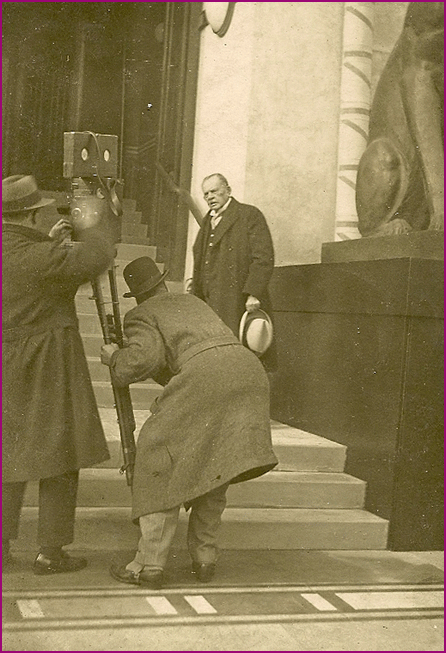
Excellent historical shot of Bernhard Baron being taken and recording for posterity the position of the cats and decorative detail - shame no colour images are available.
Here he is posing for the paps at the dedication of the brand new factory in 1928, when he was to proclaim it – without so much as a whiff of modern day emphysemic irony – as a most “healthy and pleasant place to work”.
The Carreras company’s origins are unclear, however Charles Dickens refers to the poor Spanish residents clustered around Somers Town in ‘Bleak House’ and census data reveals generations of tobacco traders in the area bearing the name for almost a century before. The ‘Black Cat’ brand of tabs was central to the global image of the company by the 20s, and Egyptian tobacco the weed of choice, so the theme of the building obviously made sense.
Commemorative Medal given to all employees on the opening day, November 3rd 1928 - image courtesy & © of cjbalm.com
It was wildly embraced. For the opening, actors in Egyptian regalia performed dramatics and a chariot race was even held along Hampstead Road. But alongside their architectural pretensions, the Carreras bunch were real innovators.
They had been the first fag company both to introduce cork filter tips and offer gift coupons in packets, both revolutionary moments in smoking’s chequered commercial history. The new factory was proclaimed to be the world’s most advanced, and was the first in Britain to make use of pre-stressed concrete and the radical technologies of air conditioning and dust extraction.
Image courtesy & © of cjbalm.com
Carreras Advertisement
There was an honourable effort to support workers and their families at the factory and it produced a happy working environment. In Camden History Society’s millennium project ‘Catching the Past’, a series of interviews with ex-employees reveals such workday features as subsidised lunches, sports tournaments, a Miss Carreras beauty competition and an active C.A.T.S – the Carreras Amateur Theatrical Society.
Colour-coded uniform collars ensured that workers did not stray from their correct floor on the eight story complex and there was a ban on all cosmetics for fear they might taint the tobacco, but people stayed with the firm as lifelong loyal employees.
The dream was to end in 1958 with the announcement that production was to move to Basildon in Essex, which for all intents and purposes was the countryside. Around two thirds of the staff took up the offers of resettling in houses there, commuting back to Camden Town until the move of the factory was complete.
The huge building was commandeered by the GLC who, as well as renaming it, stripped out all the quirky Egyptianisms, preferring an en vogue municipal feel as the 60s swung into action. One of the original Black Cat statues went to Basildon, the other to the company’s factory in Jamaica. Once again at Mornington Crescent, the conservationists were in vocal uproar.
The Black Cats today
Yet in the late 90s, with the GLC but a local governmental memory, a new sympathetic Taiwanese owner secured its immunity from the wrecking ball and work began to reinvent it as a ‘meeja’-focused business centre, including the restoration of almost all of the original design features. It was an award-winning execution.
So now we have faithfully true new Black Cats, jolly Lower Nile colourwash detailing and an Art Deco sight to behold as we trundle through the patchwork of styles and eras that litter Hampstead Road and Euston today. It really is a huge place that thoroughly deserves celebrating its cheery if vaguely ridiculous historic scrub-up.
And the Carreras company qualities of innovation-in-product, workplace and seismic social upheavals are back too, courtesy of current residents like internet fashion dynamos ASOS, global media giants EMAP, marketing gurus Wunderman, spinal fitness gym Kieser Training and the British Heart Foundation.
Mr Baron, who died only a few months after the opening, would surely be lighting up a ‘Craven A’ if he knew how the building has been preserved.
Black Cat Tit-Bits
1916
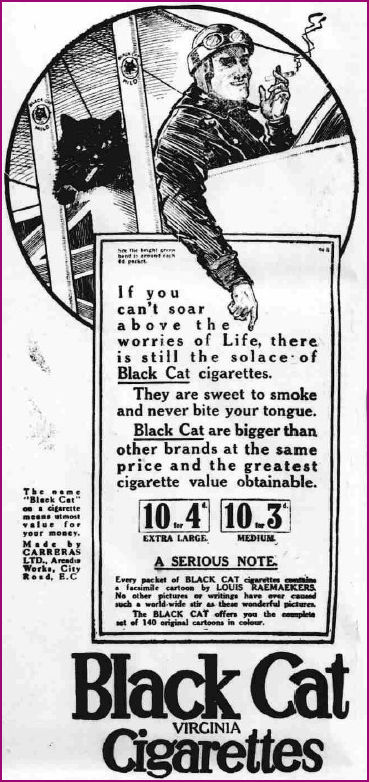
Leeds Mercury - Tuesday, 31st October 1916 - image sourced from the British Newspaper Archive
An Advert for Black Cat Cigarettes 1916 portraying a patriotic pilot and cat-co-pilot (with Union Jack) showing both enjoying a Black Cat cigarette (not sure what the current animal welfare organisations would think of that) and in addition to all the life-balance benefits there is even an offer stating that every packet contains a Louis Raemaekers (Dutch Artist/Political Cartoonist 1869–1956) original 'facsimile cartoon' of which there are 140 to collect! How's that as an incentive ......
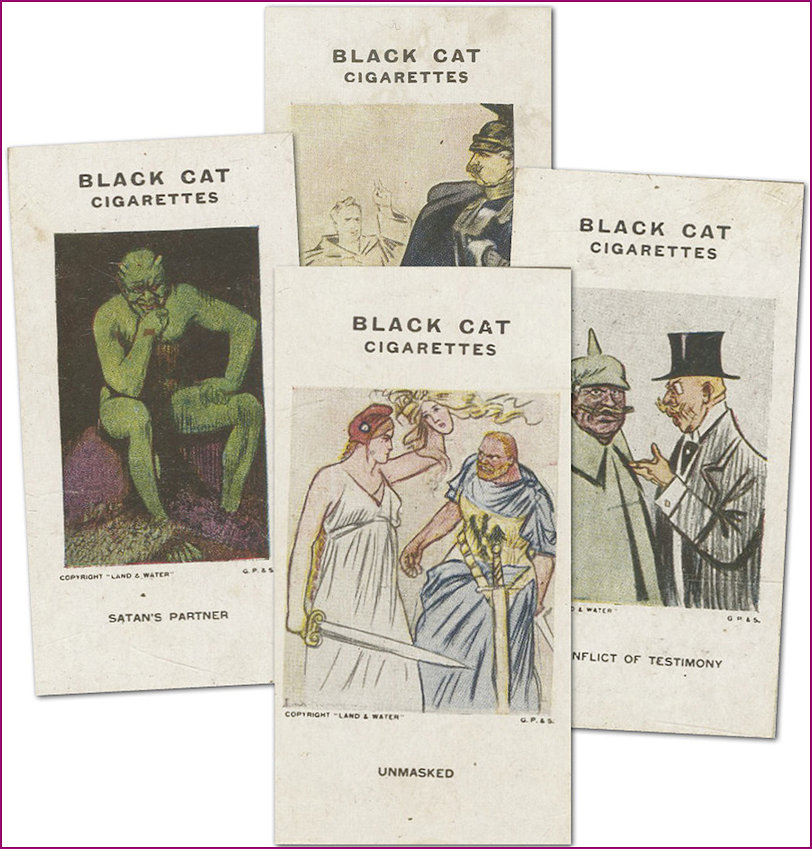
An example of four collectable cards that feature Raemaekers' War Cartoons*. These were produced by Black Cat Cigarettes in 1916. - Image sourced from illustrationchronicles.com with thanks
*Despite the questionable origins of some his work's inspiration, the demand for his cartoons was truly staggering. By 1916, his acclaim and influence had reached unparalleled heights. There were pamphlets and albums; posters and postcards. Cigarettes would come with Raemaekers cards depicting his spine-chilling cartoons; while audiences attended live performances with British illustrators recreating some of his most famous work live on stage. His drawings were exhibited on all five continents, and some aristocratic households even held special afternoons where his drawings were staged as elaborate tableaux vivants. Source : illustrationchronicles.com
Three Visceral Examples of 'War Cartoons'

The Widows of Belgium - image sourced from and courtesy of gutenberg.com
This deeply pathetic picture evokes the memory of many sad and patient faces which we have seen during the last eighteen months. It is the women, after all—wives, mothers, sisters, and daughters—who have the heaviest load to bear in war-time. The courage and heroism which they have shown are an honour to human nature. The world is richer for it; and the sacrifices which they have bravely faced and nobly borne may have a greater effect in convincing mankind of the wickedness and folly of aggressive militarism than all the eloquence of peace advocates. We must not forget that the war has made about six German widows for every one in our country. With these we have no quarrel; we know that family affection is strong in Germany, and we are sorry for them. They, like our own suffering women, are the victims of a barbarous ideal of national glory, and a worse than barbarous perversion of patriotism, which in our opponents has become a kind of moral insanity. These pictures will remain long after the war-passion has subsided. They will do their part in preventing a recrudescence of it. Who that has ever clamoured for war can face the unspoken reproach in these pitiful eyes? Who can think unmoved of the happy romance of wedded love, so early and so sadly terminated? - The Dean of St. Pauls as it appears on gutenberg.com
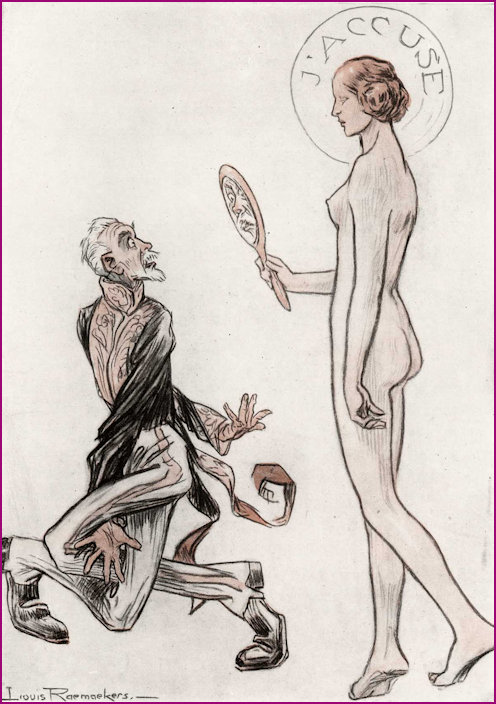
J'Accuse - VON BETHMANN-HOLLWEG AND TRUTH - "Truth is on the path and nothing will stay her." - Image sourced from and courtesy of gutenberg.com
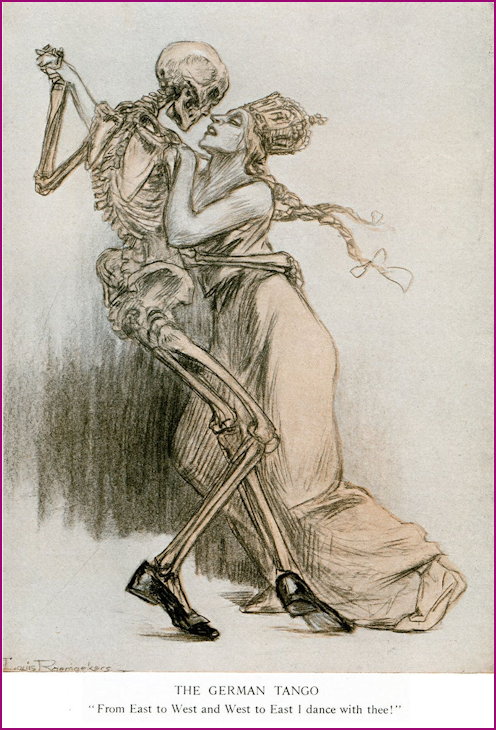
The German Tango - image sourced from and courtesy of gutenberg.com
A blond woman, wearing the Imperial crown and with her hair braided in pigtails like a German backfisch, is whirling in the tango with a skeleton partner. Her face is livid with terror and fatigue, her limbs are drooping, but she is held by inexorable bony claws. On the feet of the skeleton are dancing pumps, a touch which adds to the grimness. This ghoulish dance does not lack its element of ghastly ceremonial.
The Dance of Death has long been the theme of the moralist in art, from Orcagna's fresco on the walls of the Campo Santo at Pisa to Holbein's great woodcuts and our own Rowlandson. In Germany especially have these macabre imaginings flourished. The phantasmagoria of decay has haunted German art, as it haunted Poe, from Dürer to Boecklin. But the mediæval Dance of Death was stately allegory, showing the pageant of life brooded over by the shadow of mortality. In M. Raemaekers' cartoon there is no dignity, no lofty resignation. He shows Death summoned in a mad caprice and kept as companion till the revel becomes a whirling horror. It is the profoundest symbol of the war. In a hot fit of racial pride Death has been welcomed as an ally. And the dance on which Germany enters is no stately minuet with something of tragic dignity in it. It is a common modern vulgar shuffle, a thing of ugly gestures and violent motions, the true sport of degenerates. Once begun there is no halting. From East to West and from West to East the dancers move. There is no rest, for Death is a pitiless comrade. From such a partner, lightly and arrogantly summoned, there can be no parting. The traveller seeks a goal, but the dancers move blindly and aimlessly among the points of the compass. Death, when called to the dance, claims eternal possession. - John Buchan as it appears on gutenberg.com
1930
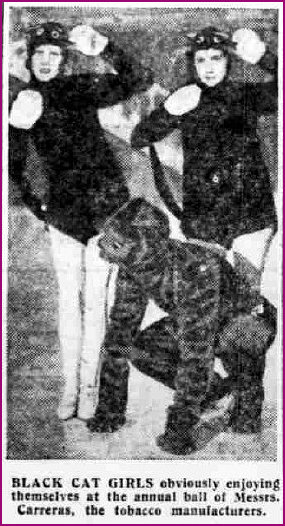
The Daily Herald - Monday 20th January 1930 - "Black Cat Girls obviously enjoying themselves at the Annual ball of Messrs. Carreras, the tobacco manufacturers" - image sourced from the British Newspaper Archive
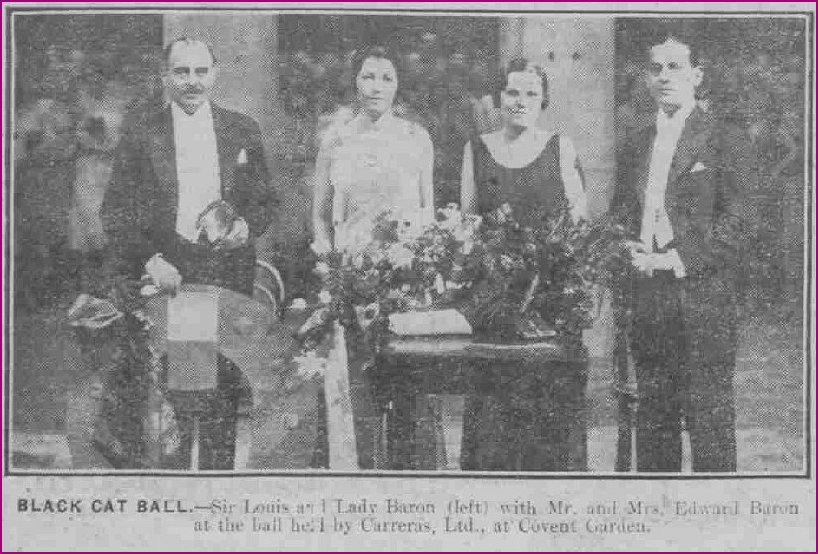
Sunday Mirror - Sunday 19th January 1930 - "Black Cat Ball - Sir Louis and Lady Baron (left) with Mr and Mrs Edward Baron at the ball held by Carreras Ltd., at Covent Garden - image sourced from the British Newspaper Archive
Jacobean Glass
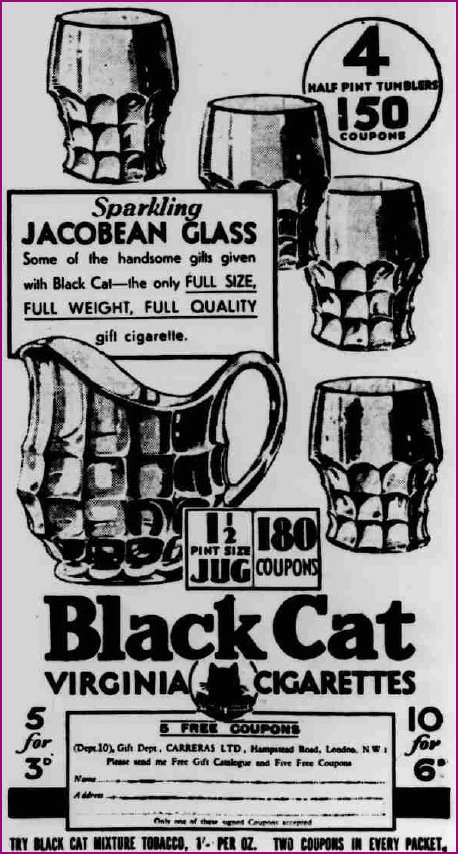
Daily Herald - Wednesday, 20th August 1930 - Jacobean Glass offer with Black Cat Cigarettes - - image sourced from the British Newspaper Archive
Kodak Film

Leeds Mercury - Friday 16th May 1930 - Kodak Film Offer with Black Cat coupons - image sourced from the British Newspaper Archive
Lascelles Cutlery

Evening Herald (Dublin) - Wednesday 26th November 1930 - Lascelles Cutlery Offer with Black Cat Cigarettes - image sourced from the British Newspaper Archive
Mickey Mouse Coupons
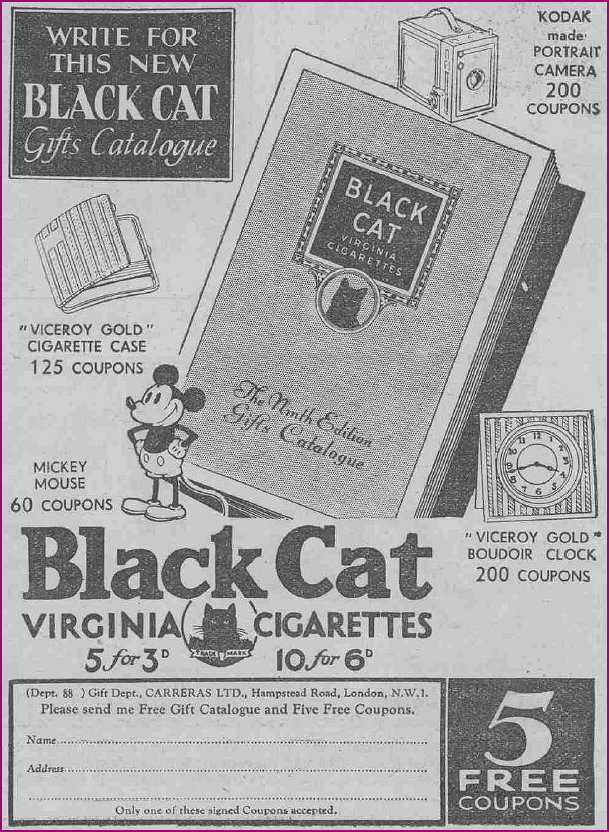
Daily Mirror - Friday 11th April 1930 - a promotion featuring Mickey Mouse Coupons to be collected using the new 9th Edition of the Black Cat Gifts Catalogue - image sourced from the British Newspaper Archive
Quality Cigarettes
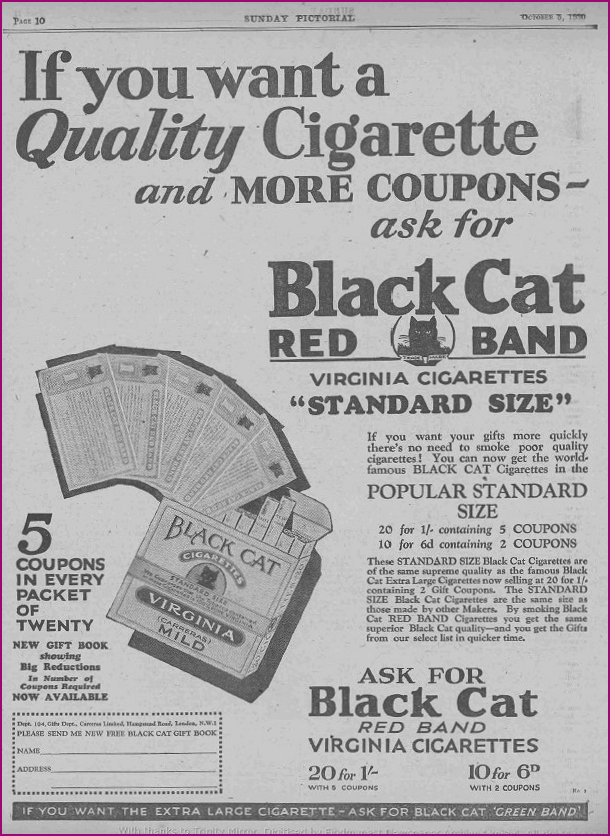
Sunday Mirror - Sunday 5th October 1930 - Advertisement for Black Cat Red Band Virginia Cigarettes - image sourced from the British Newspaper Archive
'Savoy' Easy Chair
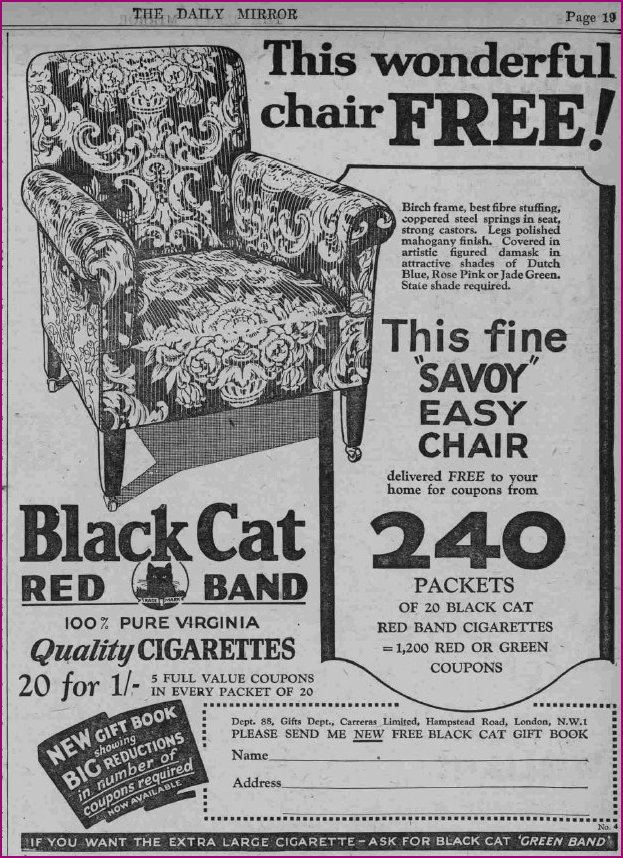
Daily Mirror - Friday, 17th October 1930 - Fine 'Savoy' Easy Chair Offer - image sourced from the British Newspaper Archive
1931
Front Page Splash!
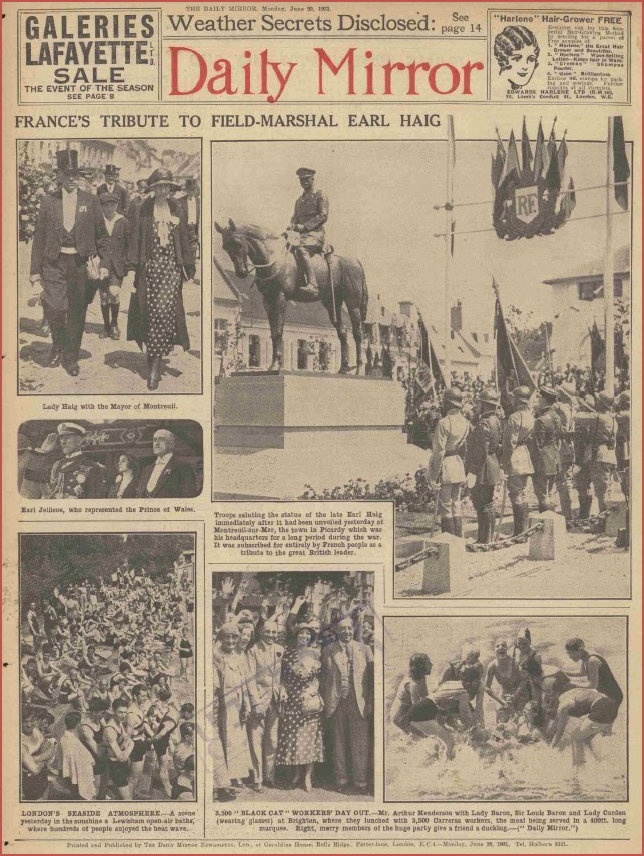
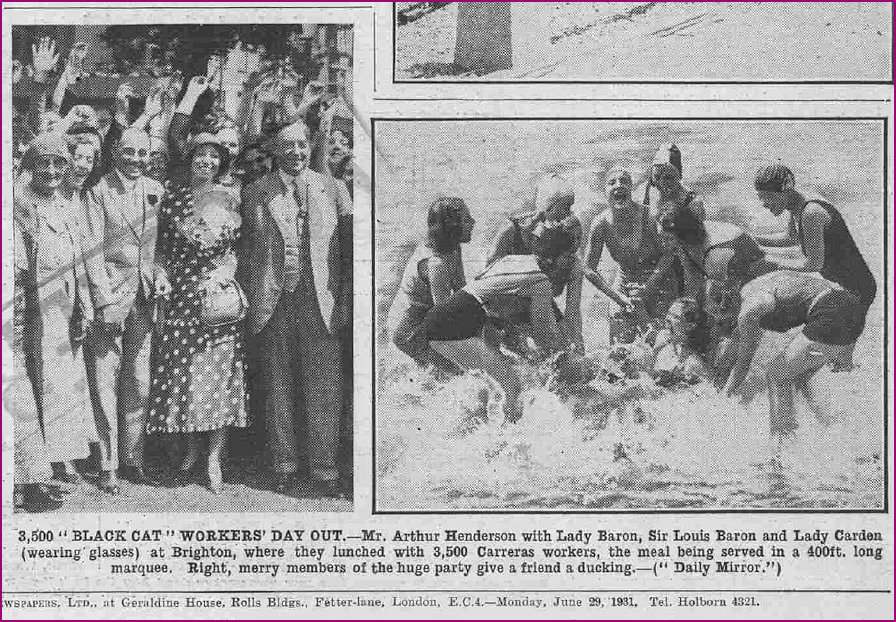
Daily Mirror - Monday, 29th June 1931 - images sourced from the British Newspaper Archive
3,500 "Black Cat" Workers Day Out. Mr. Arthur Henderson with Lady Baron, Sir Louis Baron and Lady Carden (wearing glasses) at Brighton, where they lunched with 3,500 Carreras workers, the meal being served in a 400 ft long marquee. Right, merry members of the huge party give a friend a ducking. - ("Daily Mirror.") Source : British Newspaper Archive
The Great Illuminations of 1931
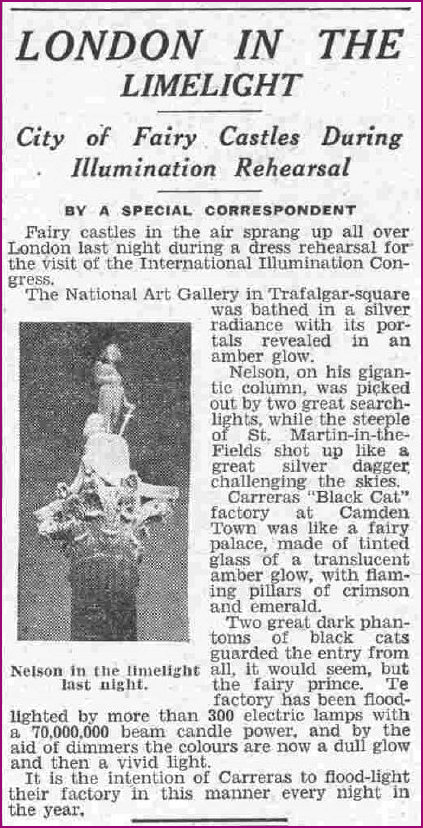
Daily Mirror 29th August 1931 - London in the Limelight - City of Fairy Castles During Illumination Rehearsal - image sourced from the British Newspaper Archive
BY A SPECIAL CORRESPONDENT Fairy castles in the air sprang up all over London last night during a dress rehearsal for' the visit of the International Illumination Congress. The National Art Gallery in Trafalgar-square was bathed in a silver radiance with its portals revealed in an amber glow. Nelson, on his gigantic column, was picked out by two great searchlights, while the steeple of St. Martin-in-the- Fields shot up like a great silver dagger, challenging the skies. Carreras "Black Cat" factory at Camden Town was like a fairy palace, made of tinted glass of a translucent amber glow, with flaming pillars of crimson and emerald. Two great dark phantoms of black cats guarded the entry from all, it would seem, but the fairy prince. The factory has been floodlighted by more than 300 electric lamps with a 70,000,000 beam candle power, and by the aid of dimmers the colours are now a dull glow and then a vivid light. It is the intention of Carreras to flood-light their factory in this manner every night in the year. Source - Daily Mirror

Illustrated Sporting and Dramatic News - Saturday, 19th September 1931 - image sourced from the British Newspaper Archive
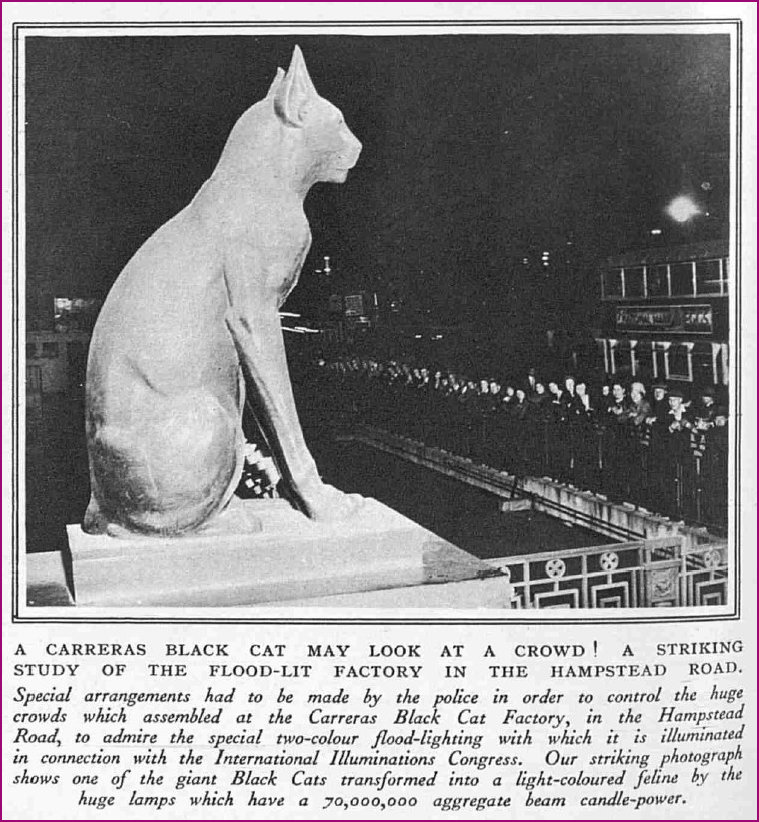
The Sketch - Wednesday, 16th September 1931 'A Carreras Black Cat may look at a crowd!' - image sourced from the British Newspaper Archive
The plagiarism of 'A Cat May Look at a King' is not lost on us in this headline! But, what about that row of early paparazzi eh?
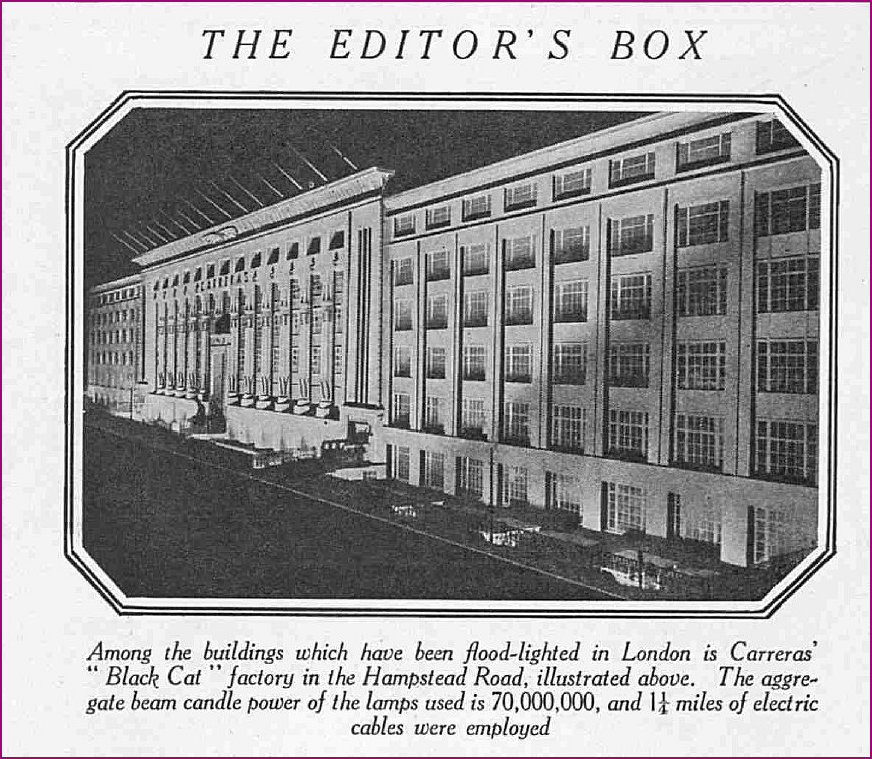
The Bystander, 16th September 1931 - image sourced from the British Newspaper Archive
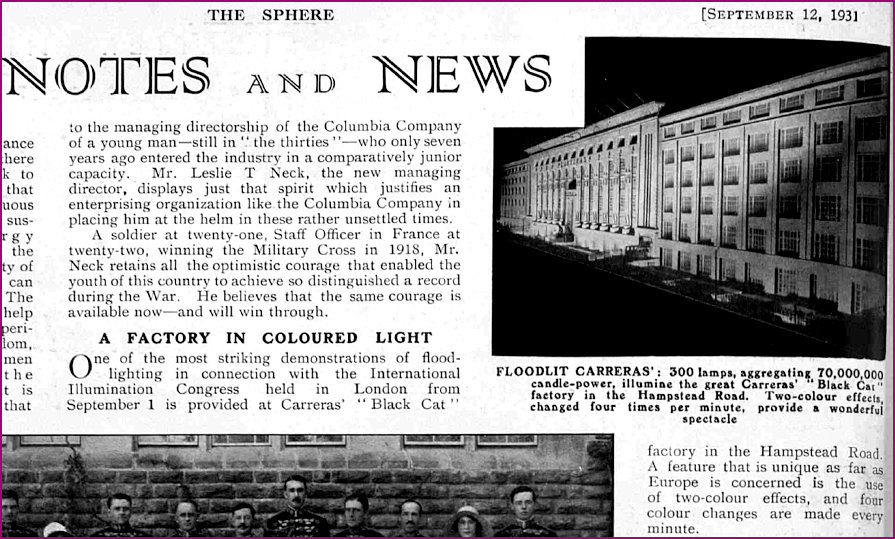
The Sphere, 12th September 1931 - Floodlit Carreras : 300 lamps aggregating 70, 000,000 candle-power, illumine the great Carreras "Black Cat" factory in the Hampstead Road. Two-colour effects, changed four times per minute, provide a wonderful spectacle. - Image and description sourced from the British Newspaper Archive
A FACTORY IN COLOURED LIGHT - One of the most striking demonstrations of floodlighting in connection with the International Illumination Congress held in London from September 1 is provided at Carreras' Black Cat factory in the Hampstead Road. A feature that is unique as far as Europe is concerned is the use of two-colour effects, and four colour changes are made every minute. Source : the British Newspaper Archive
Another spectacular Getty image giving us an insight into the hitherto described lighting rigs - 'Black Cat Statue
27th August 1931: Floodlighting of the Carreras Building on Hampstead Road in Camden, once home to the 'Black Cat' cigarette manufacturing firm of Messrs Carreras, now Greater London House'. (Photo by Fox Photos/Getty Images) image and strapline © of Getty Images
Annual Black Cat Party Time!
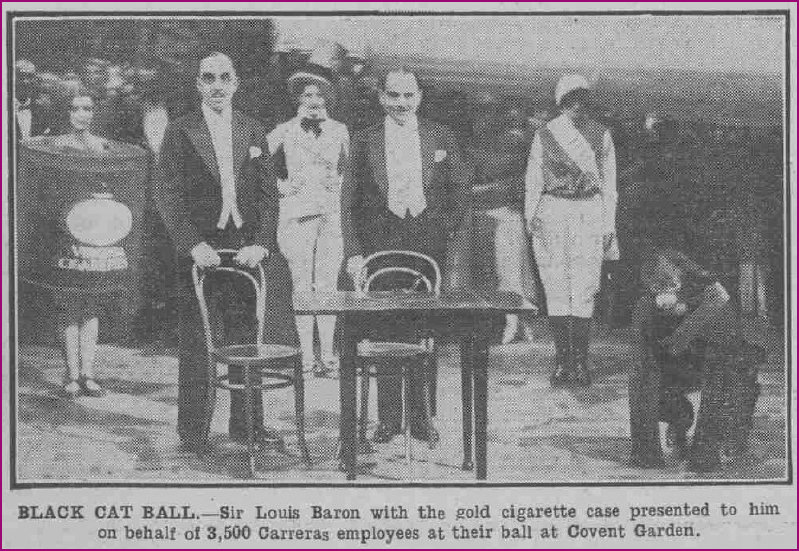
Sunday Mirror - Sunday 25th January 1931 "Black Cat Ball - Sir Louis Baron with the gold cigarette case presented to him on behalf of 3,500 Carreras employees at their ball at Covent Garden" - image sourced from the British Newspaper Archive
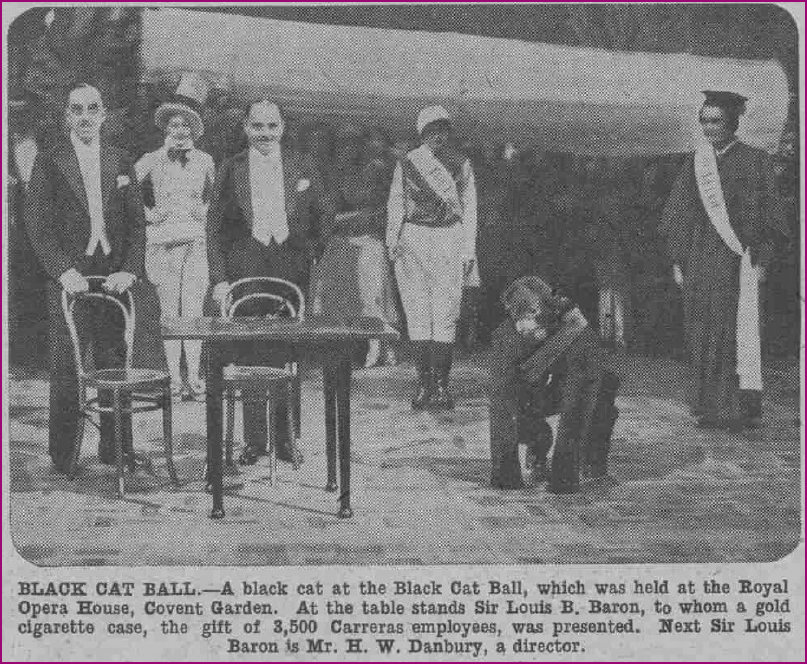
Daily Mirror - Monday 26th January 1931 - Black Cat Ball - A black cat at the Black Cat Ball, which was held at the Royal Opera House, Covent Garden. At the table stands Sir Louis B. Baron, to whom a gold cigarette case, the gift of 3,5000 Carreras employees was presented. Next Sir Louis Baron is Mr H W Danbury, a director" - image sourced from the British Newspaper Archive
'Black Cat Camera' Competition
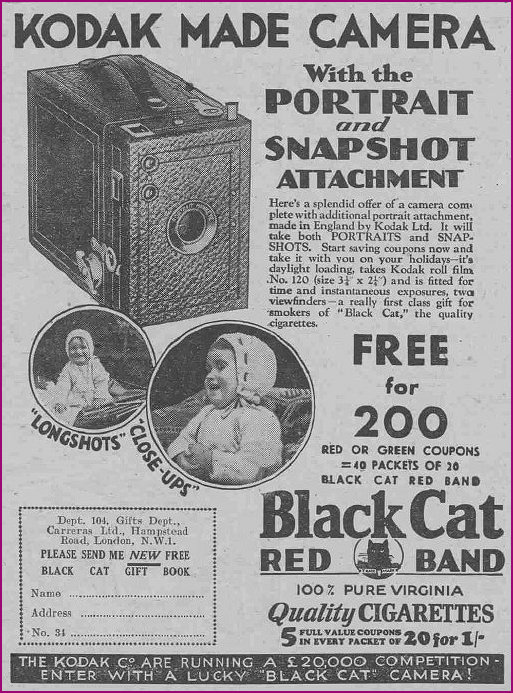
Sunday Mirror - Sunday 24th May 1931 - Enter a competition to win £20,000 using a 'Lucky Black Cat' Camera - image sourced from the British Newspaper Archive
Willow Pattern
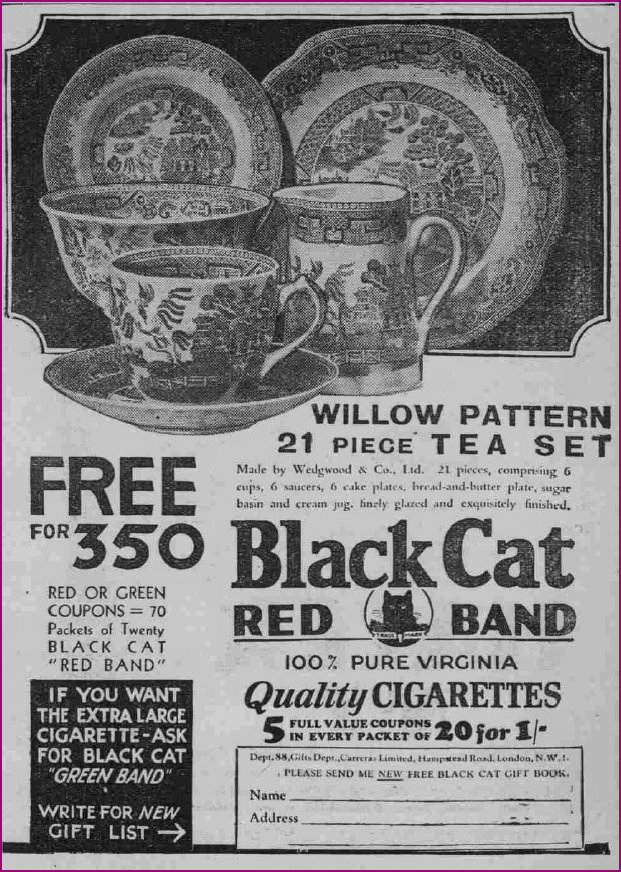
Daily Mirror - Saturday, 28th March 1931 - 21 Piece Willow Pattern' Tea Set - image sourced from the British Newspaper Archive
1933
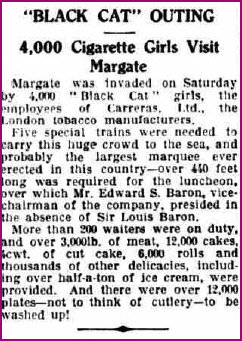
Birmingham Daily Gazette - Monday 19th June 1933 - image sourced from the British Newspaper Archive
"BLACK CAT" OUTING 4,000 Cigarette Girls Visit Margate Margate w•as invaded on Saturday by 4,000 " Black Cat " girls, the employees of Carreras, Ltd., the London tobacco manufacturers. Five special trains were needed to carry this huge crowd to the sea, and probably the largest marquee ever erected in this country—over 410 feet long was required for the luncheon, over which Mr. Edward S. Baron, vice-chairman of the company, presided in the absence of Sir Louis Baron. More than 200 waiters were on duty, and over 3,0001 b. of meat, 12,000 cakes. 4cwt. of cut cake, LOW rolls and thousands of other delicacies, including over half-a-ton of Ice cream, were provided. And there were over 12,000 plates—not to think of cutlery—to be washed up!
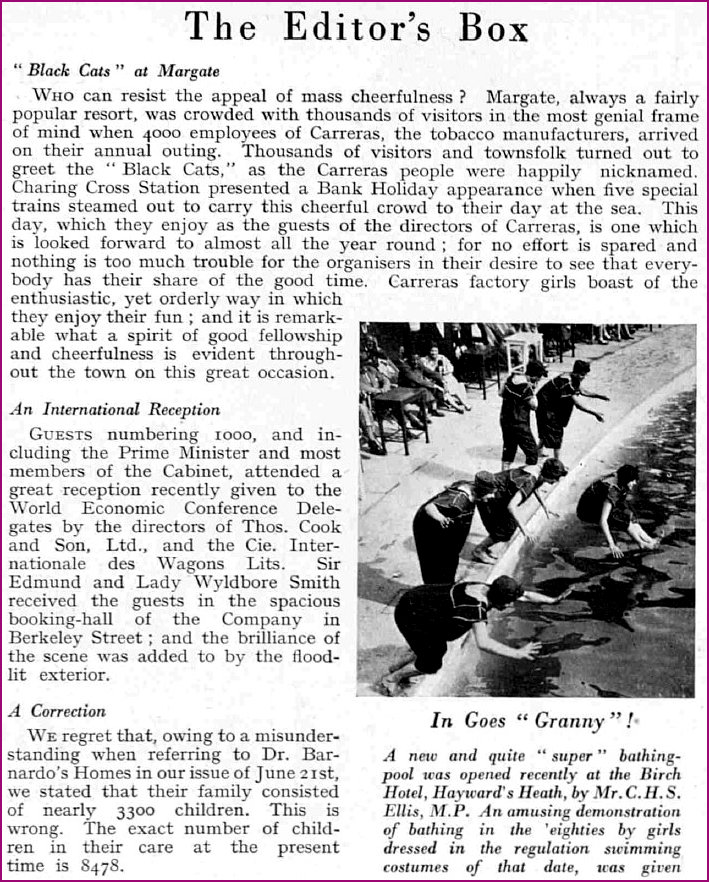
The Bystander - Wednesday 5th July 1933 - image sourced from the British Newspaper Archive
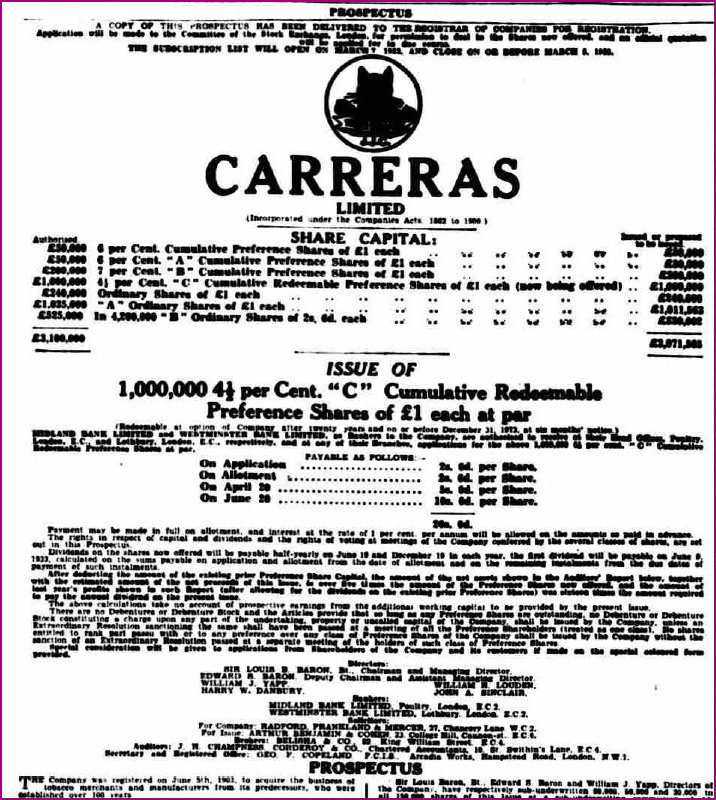
Daily Herald - Monday, 6th March 1933 - Black Cat Shares Announcement - image sourced from the British Newspaper Archive
1936
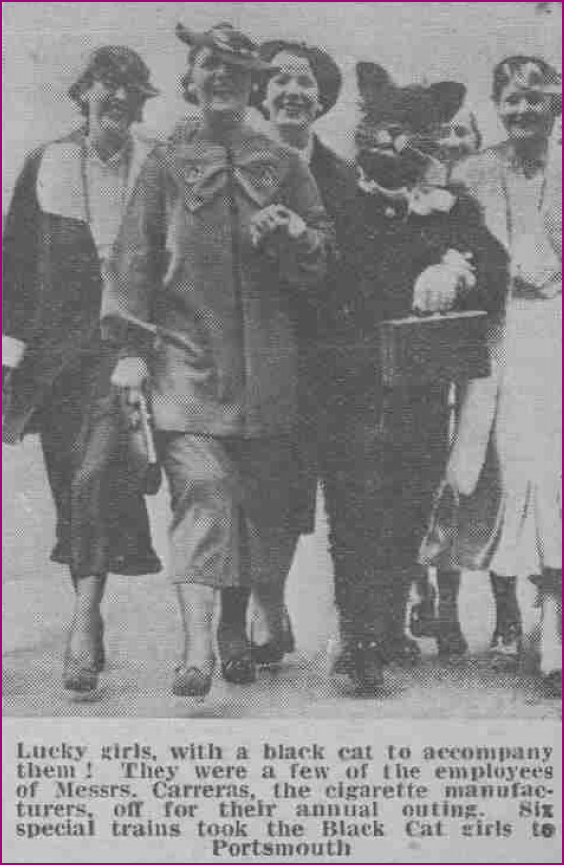
Sunday Mirror - Sunday 21st June 1936 - "Lucky girls with a black cat to accompany them! They were a few of the employees of Messrs. Carreras, the cigarette manufacturers, off for their annual outing. Six special trains took the Black Cat girls to Portsmouth" - image sourced from the British Newspaper Archive
Really, I should know by now that if there is a photo in the Press a decent image of it and a strapline can be found over at Getty images! - 'Black Cat Girls Leave For Annual Outing - A contingent of 'Black Cat girls', employees of Messrs. Carreras the cigarette manufacturers, leave Waterloo Station in London in six special trains on their annual outing, this year to Portsmouth'. (Photo by Hulton Archive/Getty Images)
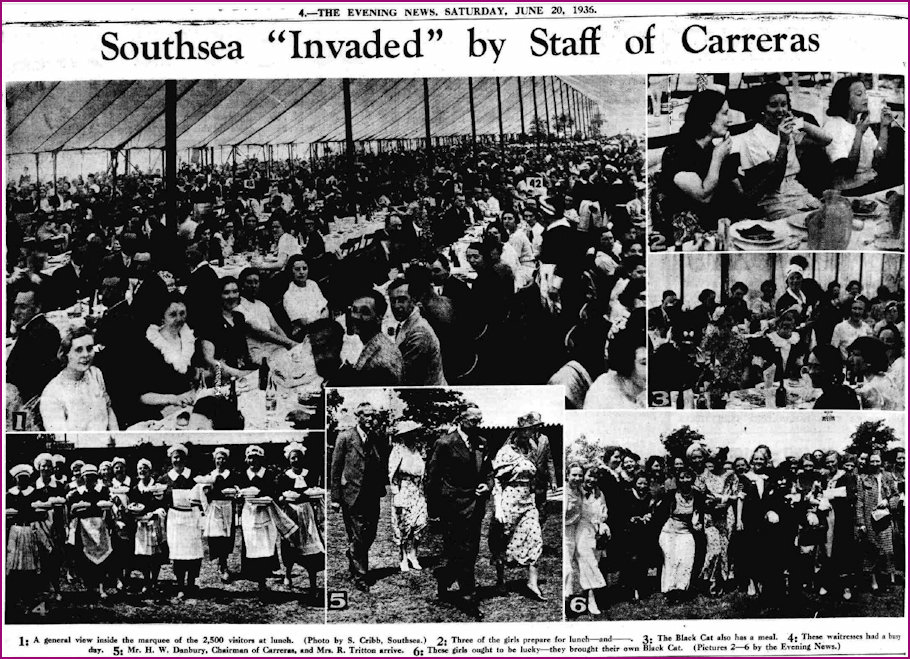
Portsmouth Evening News - Saturday 20th June 1936 - image sourced from the British Newspaper Archive
Page refreshed : 1st March 2021 (G)
